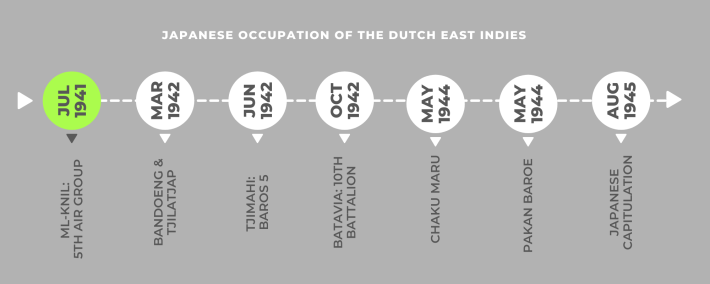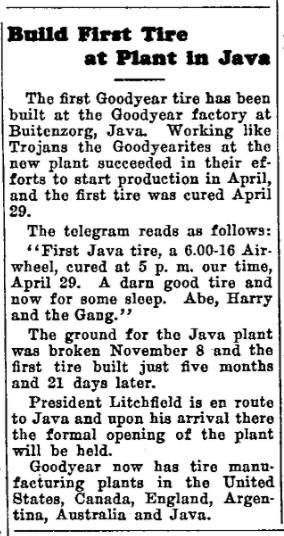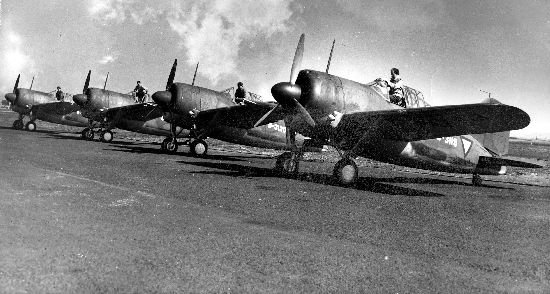One of the problems with doing genealogy research is that it is easy to get distracted by new findings. They are the shiny new findings that are interesting and take one on a previously unexplored historical adventure. Without a doubt, I’ve done a lot of that in the last couple of years. I now have four family trees on Ancestry.com, a little over 2,900 people in the trees, and a decent system for organizing the documents that I find. Whew! There are so many fascinating stories out there, but now it’s time to get back to writing about my dad’s family.
My Opa – Johannes Hubertus Theodorus Gerardu
In my last post, I ended with my grandfather’s arrival as a POW in Pakan Baroe, on the island of Sumatra, in May 1944. However, before I write about Pakan Baroe, I want to go back to the period right before the occupation of the Dutch East Indies (DEI, now Indonesia) by the Japanese in March 1942.
It was a period of great uncertainty for everyone. After the Netherlands had surrendered to the Nazi forces in May 1940, the DEI operated somewhat independently for two years. Meanwhile, Japan was posturing that it intended to create a bloc of self-sufficient Asian nations, led by Japan, which was to be free of any Western influence. This intention was announced by Foreign Minister Hachirō Arita on June 29, 1940. Then on September 27, 1940, Japan, Germany, and Italy signed the Tripartite Pact. It was a defense alliance intended to discourage the United States from entering the conflicts. These events are only the high-level indicators of what was brewing. As the war continued to rage in Europe, the Koninklijk Nederlands-Indisch Leger (KNIL) or Royal Netherlands East Indies Army frantically prepared for a possible invasion in the Pacific.
Google Translate is available at the bottom of the page.
Establishment of Semplak Airfield
On June 1, 1941, the 5e Vliegtuiggroep (5th Air Group) was established in Semplak. It was a hastily constructed airstrip consisting of two runways, a handful of buildings (including a former rice mill and a lunatic hospital), and a control tower. Because it was otherwise occupied, the Netherlands was behind in the race to secure military equipment. This new airfield was initially equipped with Curtiss Interceptors, then later replaced with American Brewster F2A Buffalo fighters. Shortly after that, on July 23, 1941, my grandfather (Opa) joined this group as the Sergeant in charge of the kitchen. This was his twelfth assignment in the twenty years he had been in the KNIL. I guess my dad wasn’t kidding when he said that he lived all over Java!
Where They Lived
My interest in these stories is not about military strategy or airplanes. Instead, I want to understand what it was like for my family members who lived during these times and in these places. The Dutch East Indies is an entirely different world than what I know in the United States. It’s also an opportunity to learn a little bit more about my dad.

Since Opa was a Sergeant, the family lived off base in Buitenzorg, at Gang Pabaton 4. While the address still comes up in Google Maps, when I showed my dad, he did not recognize the house, so it’s fair to assume that it was replaced. The house consisted of four raised buildings connected by wooden walkways. They were raised was because it rained so much. The main house had yellowish-white exterior walls, a brown tile roof with big overhangs, and the floors inside were green tile. There were three bedrooms. The outbuildings consisted of a kitchen, a bathroom, and the gudang (shed) were made of gedek (woven bamboo walls) covered with gypsum. The family stayed in the main house, and the servants stayed in the gudang. It’s hard to imagine that they had servants, but it was common for the Dutch at that time. They all slept on mattress sacks stuffed with kapok tree fiber, which was less expensive than cotton. My dad remembers having to regularly beat his mattress to get the bugs out. Ewwww. It was common to get mosquito bites daily, so they slept with mosquito nets covering the bed and rubbed their skin with crushed citronella leaves.
The bathroom was a separate building in the back for a practical reason, the open sewer system. The system consisted of gullies with running water, and the squat toilets were positioned over the gullies. In their case, it was merely a hole in the floor. Another ewwww! Since there was no running water, there was a large basin that had to be filled daily. This was my dad’s job, which took about an hour, and explains his lifetime obsession with watching how much water people use! The bathroom probably looked something like this, but with bamboo walls and minus the fancy squat toilet.

Getting Around
The airfield in Semplak was located about 12 km (7.5 miles) north of Buitenzorg (now Bogor), in West Java. Opa took a military bus to work every day, but everyone else rode bikes or walked. When they moved to Buitenzorg, my dad enrolled in a private school named Notaris de Graaf-Stichting. It was a secondary school, a hogere burgerschool (HBS) in Dutch. The school was run by the Freemasons, and lessons were taught in Dutch. Because the nearest public HBS was located in Batavia (now Jakarta), the son of a KNIL Sergeant went to a private school with American children of Goodyear management. The Goodyear plant, established in 1935, manufactured tires. This was a whole new experience for a so-called army brat. While he hung out with these children at school, their lives did not cross otherwise.
His older sister Lies was already married and no longer lived at home. His younger sisters, Truus and Mien, attended the Catholic primary school in Buitenzorg.
Mobilization of the 5th Air Group
By December 1, 1941, the 5th Air Group was mobilized and, in theory, sufficiently staffed. However, similar to much of the ML-KNIL (air division of the KNIL) was not up to combat strength. Many of the planes it had ordered had not been delivered, and some were obsolete models. Add to that, many of the pilots were fresh out of flight school with only a few hours of experience flying the Buffaloes, let alone firing at aerial targets.
The British Royal Air Force (RAF) in Malaya and Singapore had similar problems, few spare parts, insufficient support staff on the ground, poorly situated airfields vulnerable to attack, and an inadequate number of trained pilots.
When Japan launched its attack on Pearl Harbor on December 8, 1941. The next day it started its invasion of Malaya and Singapore, so it was time to put the 5th Air Group into action.
On December 9, 1941, nine Buffaloes from the 5th Air Group, 2nd Squadron (2-VLG-V), under the command of Captain van Helsdingen, were sent to Singapore to help the RAF in the fight there. According to my dad, Opa joined them. They were stationed at the Kallang Airfield at the eastern tip of Singapore. It was the only operational fighter airfield in Singapore out of range of Japanese artillery at Johor Bahru (~33 km/20 miles away). At the time, it had grass runways.
During their time there, they fought with the RAF to prevent the Japanese invasion of the Malaya region. They flew three missions, taking down four Japanese 47s, but lost two planes and one pilot. On January 18, 1942, they were called back to defend Java several weeks before the battles that led to the fall of Singapore. Opa returned to Semplak with Capt. van Helsdingen and seven Buffaloes.
Opa’s first twenty years of service in the KNIL were relatively uneventful. They moved often, but he had a family and a stable income. However, between July 1941 and January 1942, this period was likely the most chaotic six months of his service to date. During this period of intensifying unrest, he had a new assignment at a new, hastily constructed airfield, a hint of combat, plus a growing concern for his family’s safety. Unfortunately, it was only the beginning of what became a 3.5-year ordeal.
Resources
Allied Geographical Section. (1945). Semplak Airfield. Semplak Airfield. https://repository.monash.edu/items/show/38109#?c=0&m=0&s=0&cv=0&xywh=-5104%2C-760%2C15208%2C8773
Baxter, J. (n.d.). Destination Java | COFEPOW. COFEPOW – The Children (& Families) of the Far East Prisoners of War. Retrieved November 11, 2020, from https://www.cofepow.org.uk/armed-forces-stories-list/destination-java
Britannica, T. Editors of Encyclopaedia (2020, September 20). Tripartite Pact. Encyclopedia Britannica. https://www.britannica.com/topic/Tripartite-Pact
Casius, G. (n.d.). Brewster Buffaloes for the Militaire Luchtvaart KNIL. The Warbird Forum. Retrieved January 2, 2021, from https://www.warbirdforum.com/casius.htm
Dan Ford, D. (n.d.). Brewster Buffalo: in Dutch service. The Warbird’s Forum. Retrieved February 14, 2021, from https://www.warbirdforum.com/dutch.htm
Pacific War Timeline – War in the Pacific | NZHistory, New Zealand history online. (n.d.). New Zealand History. Retrieved February 15, 2021, from https://nzhistory.govt.nz/war/second-world-war/war-in-the-pacific/timeline
Stevens, T. (1994). Vrijmetselarij en samenleving in Nederlands-Indië en Indonesië [E-book]. Uitgeverij Verloren. https://books.google.com/books?id=78xaVtWeatoC&pg=PA306&lpg=PA306&dq=%22Notaris+de+Graaf-Stichting%22+%22Buitenzorgse%22+School&source=bl&ots=992czsyE18&sig=ACfU3U0o-JQpFt6Gewc3uUV-pkFedTTtXQ&hl=en&sa=X&ved=2ahUKEwjO_cDgwbTrAhXxNX0KHWq4B6UQ6AEwAHoECAEQAQ#v=onepage&q=%22Notaris%20de%20Graaf-Stichting%22%20%22Buitenzorgse%22%20School&f=false
Suwandy, I. (2016, October 13). The Dai Nippon Occupation Java Part One 1942 history collections. Driwancybermuseum’s Blog. https://driwancybermuseum.wordpress.com/2012/06/15/tha-dai-nippon-occupation-java-part-one-1943-history-collections/
Weintraub, R. (2015). No Better Friend: One Man, One Dog, and Their Extraordinary Story of Courage and Survival in WWII (Stated First Edition, First Printing ed.) [E-book]. Little, Brown and Company. https://www.amazon.com/No-Better-Friend-Extraordinary-Survival-ebook/dp/B00NERQSSE/ref=tmm_kin_swatch_0?_encoding=UTF8&qid=&sr=#detailBullets_feature_div
Wikipedia contributors. (2020, April 3). 2-VLG-V (ML-KNIL). Wikipedia. https://en.wikipedia.org/wiki/2-VLG-V_(ML-KNIL)
Wikipedia contributors. (2021, February 13). Battle of the Netherlands. Wikipedia. https://en.wikipedia.org/wiki/Battle_of_the_Netherlands
Wikipedia contributors. (2021b, February 15). Greater East Asia Co-Prosperity Sphere. Wikipedia. https://en.wikipedia.org/wiki/Greater_East_Asia_Co-Prosperity_Sphere
Wikipedia contributors. (2021a, February 2). Kallang Airport. Wikipedia. https://en.wikipedia.org/wiki/Kallang_Airport




